Preview Special Continued:
JVC DLA-HD1 D-ILA Projector
Do the first measurement results hold up to the picture impression?

Our large JVC DLA-HD1- Preview Special last week generated quite a bit of response. Home cinema fans all over the world contacted us for further information on this new projector of superlatives. Motivated by this large feedback we succeeded in arranging a second "date" with the HD1 at JVC on short notice.
Our thanks go to Mr. Gustav Emrich (JVC) and Mr. Juergen Wilkin (JVC), who made this second preview possible on such a short notice by their energetic support.

Our renewed place of appointment:
JVC in Friedberg, Germany
In this second meeting it was possible for us to take a much closer and exact look at the projector and also accomplish our first measurements. In the large conference room at JVC the HD1 was ready for us in combination with a 4m wide screen.

A cinema everyone would gladly have at home

The black HD1 Inconspicuously projected its picture
in the darkness
In this second Preview Special we now present the first "Hard Facts" concerning the new reference LCOS projector from JVC:
1. Menu and offered options
So far, there was very few information regarding the menu of the projector and the functions it offered, above all in the picture menu. Therefore we first looked at all the parameters for adjustment.
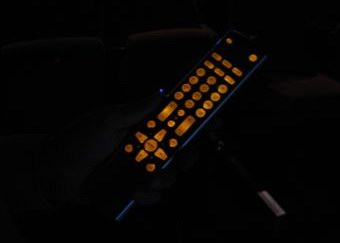
The well lit remote control
facilitated the operation uncommonly
The menu structure of the DLA-HD1 is divided into six main categories, "Image", "Setup", "Video", "Install", "Func." and "Info.". Here are the categories in the detail:
1.1 "Image" category
Like the name implies, this category contains substantial Image parameters. Typical adjustment parameters, which might be common to the specialist, are clearly arranged one above the other :

The "Image" menu of the HD1
In the Submenu "Image Adjust" all basic parameters such as Contrast, Brightness, Color etc. can be found. With these, a quick alignment on the signal source is possible.

The functions "Sharpness" and "DNR" are particularly worth mentioning, with which the excellent noise correction of the used Gennum signal processing chip set can be configured.
We continue with "Color Temp": Here, a healthy mixture of factory presets and user adjustment possibilities is offered. Three color temperatures can be selected, "Low", "Mid" and "High", with which the "Low" setting is to correspond to a D65-calibration; more to that in the Picture test. Those who would like to adjust the color temperature manually can do so by means of the RGB sliders. In direct connection to this is the "Offset" submenu, which allows for an additional RGB alignment for dark ranges.

In the "Gamma" menu, different Presets are also available, which we unfortunately could not seize in this Preview. JVC specialist Gustav Emrich (greetings!) described to us however that different gamma curves between 1,8 over 2,2 to 2.5 are preset. In practice this means a fast and uncomplicatedly adjustment of the gamma to personal taste and room conditions. It is not known at the moment whether external gamma software, which is available for instance for the HD2K, will also be offered for the HD1.
The last category, "Pixel Adjust", more than positively surprised us. Especially in these times of Full HD resolution the topic Convergence not rarely comes into the main focus of home cinema fans. Perfect convergence over the entire picture with a 3-chip projector of this resolution is a kind of utopia. The convergence should however be good enough to not provoke any disturbing color fringing during movie viewing. JVC offers a very small tolerance from factory, as was described to us. In addition however, the user is given the possibility to affect the convergence:

The Convergence menu of the DLA-HD1
All three(!) basic colors can be shifted both horizontal and vertically, and even over several pixels. With the help of this menu it is possible to realize a convergence shift of no more than half a pixel in the particularly important part of the picture, the picture center. Many home cinema fans will be particularly pleased about this option, which is so sorely missing in a Sony Ruby or Pearl.
1.2 "Setup" category
The second main category offers various possibilities of storing the desired picture configurations in user profiles. In addition, three factory presets are available, which are pre-configured and self-describing for different target applications.

Furthermore, with "HDMI Inputs Level" the HDMI level can be selected between PC and video. This function also facilitates the adjustment to the signal source very well. The function "Mask" remains: basically, the DLA-HD1 works completely without Overscan, thus showing a pixel-perfect representation of the entire picture content. If disturbing artifacts at the borders should be blacked out however, they can be masked with this function.
1.3 "Video" category
The third category "Video" offers different aspects of signal adjustment. Unfortunately, we could not examine all functions in their operation in this short Preview, because when the 1080p HDMI feed is used most functions are deactivated.
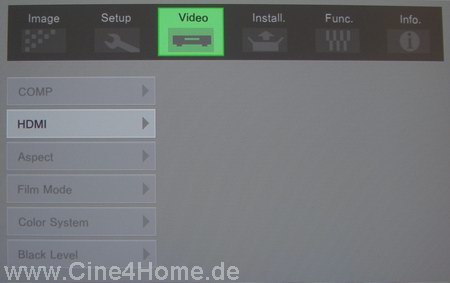
As can be seen in the screen shot above however, functions are such as Display Format, De-Interlacing, Black Level and Signal Standard (RGB, YPbPr 4:2:2, 4:4:4) can be adjusted.
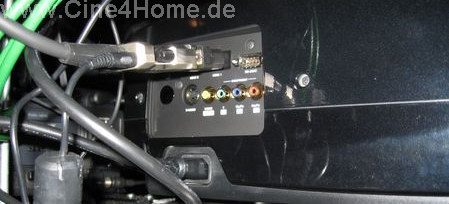
The projector was connected over HDMI
1.4 "Install" category
The Install menu self-describingly offers all relevant options for the placement of the projector.

Besides selecting between front & rear projection, the OSD menus can be adjusted the the users taste.
1.5 "Func." category
In the fifth category "Function" all options are listed which thematically did not fit into the other categories.

Three functions are particularly worth mentioning here: with "Sleep timer" users can protect the projector against the fact that it keeps running for hours and thus waste of valuable lamp life in case of a sudden sleep attack. We consider this function extremely practical and hope that this will also be more frequently found in other models in the future. With "Lamp Power" the lamp brightness can be switched between "Normal" and "High", more to this in the picture test of this Preview. The third practical function is "Testpattern", with which numerous test patterns, ranging for testing colors to image definition, can be recalled. An internal test pattern generator shows the professional origins of this D-ILA projector.
1.6 "Info" category
The sixth category offers no adjustment parameters, but does inform the user however about the fed signal and used lamp time.
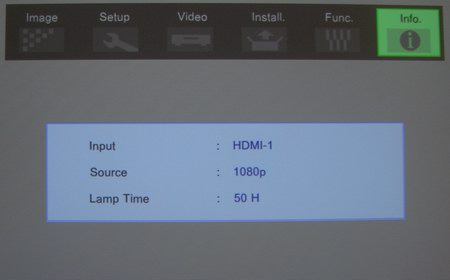
As one can see above, the pre-production machine is 50 hours old and with our Preview, native1080p material was fed, which the projector can process at 50Hz, 60Hz and also 24Hz .
Altogether the menu system of the DLA-HD1 offers numerous functions, necessary for further picture optimization, in a clear and intuitively operated way. The mixture of offered Presets and user adjustment options is well balanced and successful.
So far the starting point, which results showed now our first tests?
We want to expressly stress again that all results published here refer to a pre-production model and can therefore only be regarded as provisional reference point! A detailed test of the final machine will follow at the official introduction on the market!
2. First results of our measurements
Enough waiting, in this part of the Preview we present the first results of our measurements and their meaning for the image representation.
2.1 Color Space (Know How link here)
In the past twelve months, the Sony VPL-VW100 was clearly considered the reference machine with regard to Color Space. This projector, with its xenon lamp and its sun-similar spectrum, exceeded the video standards with its Color Space, but for many just that constituted a large part of the fascination in the color representation.
In the DLA-HD1 no Xenon lamp is used, which is beneficial to the users wallet because of the clearly lower running cost. Instead, a 200W UHP lamp was used, as usual for home cinema projectors. This lamp however does not offer as balanced a spectrum as the expensive and elaborate Xenon variant. In order not to get any deficits in the colors, JVC selected an unusual beginning:
Special filters are placed inside the projector, which filter out undesired spectral portions of the UHP light and will pass only selected spectral portions. The particularly disturbing yellow portions of green are eliminated that way, which benefits the color representation. This way, the projector does loose some light (without color filters the HD1 would be able of achieving far over 1000 Lumen), but a similar Color Space as with a Xenon lamp is realized. And this well thought out method was confirmed in our measurements: the projector actually has an uncommonly large Color Space, which can even hold up with the Sony Ruby.
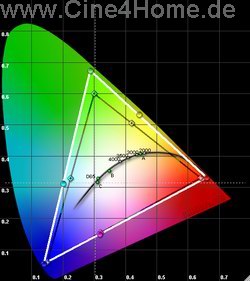

Left: Color Space of the DLA-HD1, Right: Sony VPL-VW100 (Ruby)
In the comparison can be seen that the Color Space is about the same size, only with red the Xenon lamp offers even more room for strong colors. These results are impressive, since two completely different lamp techniques are in use here. A comparison to the Sony VPL-VW50 (likewise UHP) makes the difference clear:

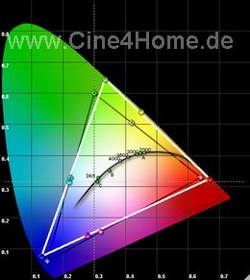
Left: Color Space of the DLA-HD1, Right: Sony VPL-VW50 (Pearl)
With regard to Color Space, minds will separate: video purists will criticize the fact that the required Color Space offers more than the video standard plans for and thus can possibly over-saturate the colors. Film fans however see a disturbing compromise especially in the reduced Color Space to the cinema original, which likewise exhibits a substantially larger Color Space. Regardless of these controversies, the running movie shows that the special filtering of the light does make an appealing and not overly exaggerated "pop off of the screen" film representation possible on the HD1.
2.2 Color Temperature (Know How link here)
Always interesting are the factory settings of the Color Temperature: here many projectors show clear weaknesses, which can usually be corrected however with the help of the picture menu fortunately. In the price range of the DLA-HD1 we set higher standards however, here we already expect a conscientious adjustment to the Color Temperature from the factory. Our expectations were fulfilled here, the measuring sensor certified an outstanding alignment to the D65 video standard of the projector, without needing readjustment from us.
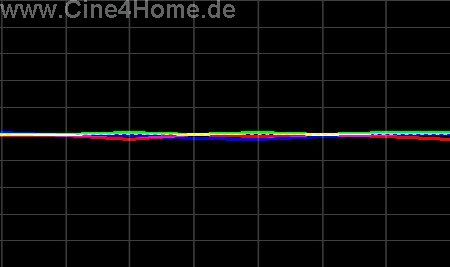
Conscientious Color Temperature calibration to D65

In this Preview we could not reliably measure under 30IRE unfortunately, since
with a display width of 4 meters constant values were measured only with difficulty. Here too no large deviations from the optimum are to be expected.
The "Low" Setting shows a conscientious white alignment to the video standard. During the presentation last week we were insured that the series model will correspond to this pre-production model. This is very promising.
2.3 Black Level, Contrast, Brightness (Know How link here)
And now we come to the most exciting part of this test. As is already known, the manufacturer JVC admits to a native contrast of 15000:1 with the DLA-HD1, without aids like for instance an adaptive iris. This value is so high that it can be believed only with difficulty. Besides that, the maximum brightness is not to suffer by this contrast optimization, and with 700 lumens the HD1 is suitable even for large picture diagonals .
Our first viewing test actually suggested an extraordinary high contrast, because the HD1 beat the Sony VW50 in a direct comparison both in Black Level and maximum brightness in a running movie. But measurement is always better: this time we had the opportunity to measure contrast and brightness with sensors. Does the HD1 actually reach 15000:1 with 700 lumens and does it actually reach this with correct colors (D65)?
Let's make it short, the answer to both questions is: "Yes!!". First we determined the contrast in the perfect Low mode (D65), presented above. In addition, we held the sensor in direct proximity of the optics, in order to receive reliable results of our measurements despite the outstanding Black Level. And our result certifies JVC's honesty with the data, as one rarely finds in the home cinema industry: the projector reached a contrast ratio of 15200:1, exactly "as promised". Also regarding brightness there is agreement concerning the manufacturer indicated data and our measurement results astonishes: the HD1 reached 695 Lumen after 50 hours of operation in High mode with D65!
But of that was not enough: in the presentation seminar last week we experienced that the projector achieves its maximum luminous efficiency not at D65, but at between 7000°K and 8000°K. We activated these with our test by selecting the appropriate color temperature preset ("High") and already with the naked eye a clear gain in brightness could be seen. The measurements proved this mode to have a brightness of 830 lumens. Also, the contrast in this mode (at 18000:1) was even higher than the factory specification.
It is highly praiseworthy of JVC that the official brightness and contrast data refer to the necessary color temperature of 6500K/D65 and not to any settings far from reality. Nevertheless: if higher light output is needed under not optimal conditions (e.g. TV in not completely dark rooms), then the projector still offers contingency reserves without the picture appearing dramatically alienated.
Measured Brightness & Contrast
JVC DLA-HD1
Color temperature:
D65 |
Color temperature:
Lamp native |
|
Lumen/lamp mode:
"normal" |
600 |
715 |
Lumen/lamp mode:
"High" |
695 |
830 |
Contrast:
|
15200:1 |
18300:1 |
The placement did not permit us to measure light output and contrast as a
function of the zoom factor. However, it was technically explained to us that
D-ILA projectors like the HD1 do not exhibit considerable fluctuations in
contrast and brightness at different distances.
Regarding contrast the projector keeps the promises its manufacturers make. The contrast results above in combination with such a good luminous efficiency can not be found elsewhere are at present in the home cinema range, at least not without aids as adaptive irises or lamp modulation.
2.4 Sharpness / Convergence (Know How link here)
Also much discussed are the sharpness and above all convergence of projectors. As already described in the first chapter, certain convergence shifts are always unavoidable with a 3-chip projector. They should however be within a non-disturbing framework.
With our test equipment this framework was placed over the entire image plane. Only a minimum shift of red showed up, which could not be seen even from small viewing distances.

Outstanding convergence with
pre-production sample

It remains to be seen whether the convergence in the series model will hold up just as well, but because of the digital convergence shift a good convergence can be always ensured in the picture center. We were very positively surprised here also. The same applies to the image definition, which is also even over the entire picture.
2.5 Shading
The aspect of the Color Uniformity is also quickly discussed: the projector did not exhibit any disturbing color clouds, neither in white nor in gray tones. Only at the lowest edge a very subtle blue glow was could be seen, which however remained invisible during movie viewing.
2.6 Picture impression
We already described our subjective picture impression in our first Preview Special. So far, no other projector combined such a plastic picture with an absolutely natural image definition and outstanding colors, like the HD1 does. In addition, there is the absence of disturbing artifacts like for instance noise, color reduction, rainbow effects etc., which are all "foreign words" for the DLA-HD1.

With a flowing grey process it becomes clear,
how good the brighntess gradation is
In the context of our test we had the benefit of being allowed to admire even more film material with the HD1. "Shakespeare in Love" was brilliant with with fine color nuances and a picture depth one does not even get in the cinema. The Black Level was so good here that even the typical boxing over and under the Cinemascope image did not disturb. Landscape photographs of a Jaguar commercial appeared so natural and deep, it felt like we were participating. And with very impressing high resolution photographs the HD1 finally proved that it is also more than suitable as a high-end "still-picture" projector.
3. Conclusion
Even after our second meeting our conclusion remains: the JVC DLA-HD1 is one of the most impressing home cinema projectors we have ever seen. The first measurement results show that all manufacturer promises are kept, even exceeded. We want to again expressly emphasize this honesty on the part of the manufacturer, and request all competitors to take this as an example. Here, the customer experiences exactly what he expects with a properly set-up projector, not any "marketing values".
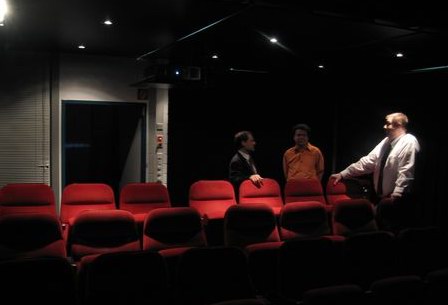
After the "Screening" some time still remained for tech-talk

Of course we could not answer all open questions in this Preview Special yet. But the results yearn for more and in the next weeks we will present a complete test in our usual detailed manner.

For us one thing is certain: after the introduction on the market, the JVC HD-DLA1 will become a lasting component of our HDTV test room. The machine hardly leaves anything to be desired taking the present state of the art into account, and we can only recommend every prospective customer to take your own look at this new wonder of contrast as fast as possible - you will not be disappointed!
18. December, 2006, Ekkehart Schmitt
Translation: Den Walterfang, December 31st, 2006.
4. Technical data (manufacturer data!)
Display device |
Full HD D-ILA device |
Panel size |
0.7 inch x 3 (16:9) |
Resolution |
1,920 x 1,080 pixels |
Lens |
X2 manual zoom/focus lens f=21.3-42.6mm F=3.2-4.3 |
Projection size |
60 inch – 200 inch |
Lens shift function |
80% vertical and 34% horizontal |
Light source lamp |
200-watt ultra high pressure mercury lamp |
Light output |
700 lm |
Contrast ratio |
15,000:1 |
Video Input Terminals |
HDMI x 2 |
Component x 1 (3RCA) can also be used as a RGB terminal. |
|
S Video terminal (mini DIN4 pin) x 1 |
|
Composite x 1 (1RCA terminal) |
|
Control Terminals |
RS-232 (D-sub9 pin) |
Video Input Signals |
480i/p, 576i/p, 720p60/50, 1080i60/50, 1080p60/50/24, NTSC/NTSC4.43/PAL/PAL-M/PAL-N/SECAM |
Noise level |
25dB (in normal mode) |
Power Consumption |
280-watt (2.7-watt while in stand-by) |
Dimensions (W x H x D) |
455 x 172 x 418mm (without extrusions) |
Mass |
11.6kg |
Provided accessories |
Power source cable x 1, self-lightening remote-control x 1, AAA size batteries, and lens cap |